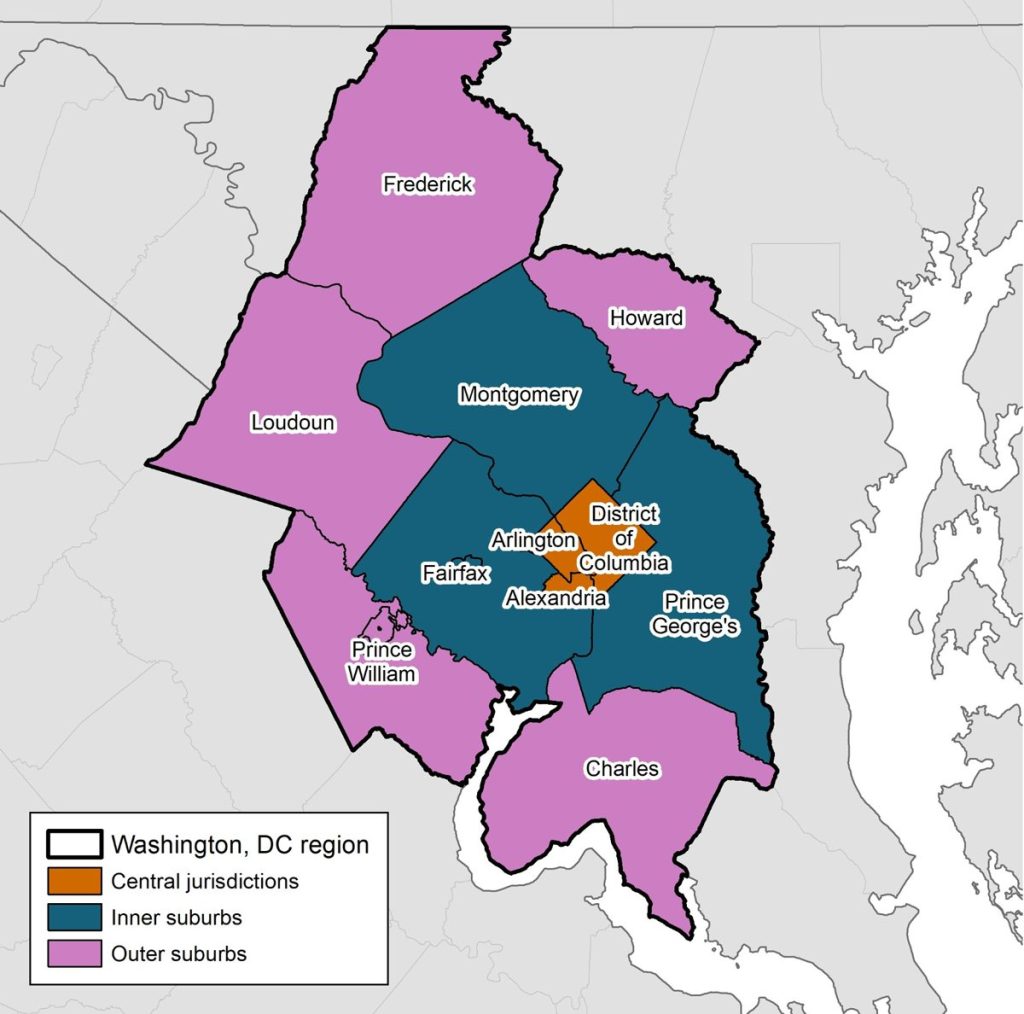Montgomery Planning’s Research and Strategic Projects Division tracks population trends to help planners and public officials plan the county’s future and determine how we can best create attractive communities and remain economically competitive in the Washington, DC region and beyond. In Part 1 of this blog series, we explained the latest U.S. Census Bureau estimates showing how Montgomery County’s population has started to rebound from the losses it experienced from COVID-19 pandemic. In this follow-up analysis, we can see how it has fared compared with the rest of the region.
Overview of our analysis
Census data estimates show Montgomery County lost fewer people to other areas of the United States during the COVID-19 pandemic and has begun recovering from those losses more quickly than other inner suburbs in the Washington, DC region. These trends signal the county’s continuing ability to attract and retain residents.
Census data also reveal that, in the decade preceding the pandemic, Montgomery County added more residents and grew more quickly than both Fairfax and Prince George’s counties. That occurred even as the county’s growth rate lagged behind the region overall.
As of July 1, 2023, the DC region had an estimated 6,042,384 residents, an increase of 31,928 people (0.53%) from the previous year (Figure 1). Montgomery County had 1,058,474 residents, remaining the second most populous jurisdiction in the region — behind Fairfax County and ahead of Prince George’s County (Figure 2). Together, the three inner suburbs represent more than half (52%) of all DC-area residents.
Even as Montgomery County’s population has partially rebounded from the pandemic, the number of residents continuing to move away underscores the need to address our high housing costs and overall housing shortage. We know both are driving many residents to less expensive areas. As highlighted in this March 2024 blog, 26,000 middle-income residents left Montgomery County between 2005 and 2022.
A closer look at the data
For comparison purposes, we grouped local jurisdictions into three areas, as illustrated in Figure 3:
- Central jurisdictions: District of Columbia, Arlington County, City of Alexandria
- Inner suburbs: Montgomery County, Prince George’s County, Fairfax County, City of Fairfax, City of Falls Church
- Outer suburbs: Charles County, Frederick County, Howard County, Loudoun County, Prince William County, City of Manassas, City of Manassas Park
Figure 3: Map of the Washington, DC region
In the 2010s, the inner suburbs experienced overall slower growth rates than the central jurisdictions and outer suburbs (Figure 4). The outer suburbs sustained rapid growth partly due to having more undeveloped land available to build new and predominantly single-family homes. Meanwhile, the central jurisdictions were part of a nationwide trend of urban redevelopment that began in the 2000s and included a multi-family residential construction boom that attracted young Millennials entering the workforce. Among inner suburbs, Montgomery County had an average annual growth rate of 0.76% during this decade, higher than Fairfax (0.58%) and Prince George’s (0.49%) counties but lower than the DC region (1.09%).
However, areas with large populations can add substantial numbers of people even with relatively slow growth rates. Montgomery County’s rate amounted to an increase of more than 76,000 residents over the decade – the third largest gain in the region behind Loudoun County and DC. Each of those added more than 107,000 people during the same period.
As noted in Part 1, Montgomery County lost residents between 2020 and 2022, during the peak of the pandemic. A similar trend occurred across the central jurisdictions and inner suburbs. From April 1, 2020 (Census Day) to July 1, 2022, the region saw a 0.49% decline in population, a loss of more than 29,000 people. During this period, Montgomery County lost nearly 9,000 residents, or 0.85% of its population. Several other jurisdictions had more severe declines. The City of Alexandria had the largest percentage decrease (-2.77%), while Prince George’s County lost the most residents (20,000 people, or 2.09% of its population). Fairfax County lost 11,000 people (0.95%). In contrast, the outer suburban counties posted continuous growth during this period, with Frederick County’s 5.83% increase (nearly 16,000 people) in the lead.
From July 1, 2022, to July 1, 2023, population increased once again across the region, helping the central jurisdictions and inner suburbs, including Montgomery County, regain population lost earlier in the pandemic. During this period, Montgomery County’s 0.51% increase mirrored the region’s growth rate of 0.53%. This placed Montgomery County in the middle of DC-area jurisdictions and ahead of Fairfax County (0.23%) and Prince George’s County (0.05%), which had the region’s lowest rate of growth. The highest rates were in Frederick County (2.03%) and DC (1.20%). In terms of numbers, Montgomery County added 5,407 people, surpassed only by Frederick County (5,851 people) and DC (8,023 people). This shows again how areas with large populations and lower growth rates can still gain a significant number of residents.
The impact of domestic migration
As described in Part 1, population changes stem from three major factors: natural increase (the number of births vs. deaths), net domestic migration (the number of people moving in from vs. out to other places in the United States), and net international migration (the number of people moving in from vs. out to other countries). During the 2010s, Montgomery County, like most DC-area jurisdictions, had declining annual growth rates. This can be attributed to falling birth rates, more deaths from an aging population, fewer immigrants due to national policy changes, and more attractive opportunities elsewhere drawing job seekers and retirees away from the DC region. As it did in Montgomery, the pandemic temporarily slowed foreign migration and affected birth and death rates across all jurisdictions.
Changes in domestic migration have had the most notable impact by far. Like Montgomery County, net domestic out-migration – more people moving out than in – increased in the region (Figure 5) and in the inner suburbs and central jurisdictions (Figure 6) through the 2010s. This trend accelerated and peaked during the height of the pandemic when population losses from people moving to other areas of the U.S. outpaced growth from natural increase and international migration. Montgomery County generally lost fewer people to net domestic out-migration than the other inner suburban counties. In the 2010s, Montgomery County lost an average of 6,889 residents annually to net domestic out-migration-- slightly fewer than Prince George’s County (6,907) and far fewer than Fairfax County (12,309). Between 2020 and 2023, Montgomery County also had the lowest annual net domestic out-migration among the inner suburbs. The county lost an average of 1.25% of its population annually (a total of almost 40,000 people over the three-year period) this way, while Prince George’s lost an average of 1.64% annually (47,000 people total), and Fairfax County lost an average of 1.51% (52,000 people total).
The outer suburban counties have had a mix of domestic migration patterns since 2010. Prince William County’s trends are like those in the central jurisdictions and inner suburbs. Howard County and Loudoun County received fewer domestic migrants over time and had net out-migration beginning in 2021. Only Charles County and Frederick County had increasing net in-migration during the 2010s and peaked during the pandemic’s first year.
From 2022 to 2023, all DC-area jurisdictions that lost population during the pandemic saw that trend reverse. Population began to grow again because the number of immigrants arriving from other countries and the number of births exceeding deaths once again outpaced losses from people moving to other parts of the country. The pace of people moving away also slowed from levels seen between 2020 and 2022. Reductions in remote work as the pandemic waned also helped Montgomery County’s population rebound.
New data will provide clarity on the direction of population trends as we move past the pandemic. The Census Bureau is expected to release county-level population estimates for 2024 in March 2025.
Note: Data referencing the DC region also includes the population of four small independent cities in Virginia: Fairfax, Falls Church, Manassas, and Manassas Park. These cities are not analyzed separately here due to their small sizes.
 About the author
About the authorJames Lee is the forecaster and demographic research specialist in Montgomery Planning’s Research and Strategic Projects Division. His areas of expertise include demographic analysis, census statistics, GIS data analysis, and immigration. James has a master’s degree in geography from University of Georgia and, prior to joining Montgomery Planning, was an immigration analyst for the federal government and a GIS analyst for Gwinnett County, Georgia’s planning department.


William Fitzsimmons
When I moved to Montgomery County, MD in 1977, the population was about 1/2 million. Now, we have over a million. The questions are: How many people can we absorb, without creating social, economic, and quality of life issues? And, is there a reasonable population goal or limit for the County? I grew up in Brooklyn, NY, which had a population of about 4 million. Brooklyn was and is overcrowded and dirty for the most part. If we just keep “growing like Topsy” that just might be where we find ourselves down the road.